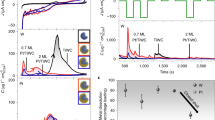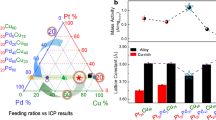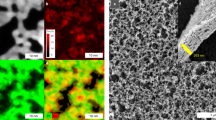Abstract
To enhance and optimize nanocatalyst performance and durability for the oxygen reduction reaction in fuel-cell applications, we look beyond Pt–metal disordered alloys and describe a new class of Pt–Co nanocatalysts composed of ordered Pt3Co intermetallic cores with a 2–3 atomic-layer-thick platinum shell. These nanocatalysts exhibited over 200% increase in mass activity and over 300% increase in specific activity when compared with the disordered Pt3Co alloy nanoparticles as well as Pt/C. So far, this mass activity for the oxygen reduction reaction is the highest among the Pt–Co systems reported in the literature under similar testing conditions. Stability tests showed a minimal loss of activity after 5,000 potential cycles and the ordered core–shell structure was maintained virtually intact, as established by atomic-scale elemental mapping. The high activity and stability are attributed to the Pt-rich shell and the stable intermetallic Pt3Co core arrangement. These ordered nanoparticles provide a new direction for catalyst performance optimization for next-generation fuel cells.
This is a preview of subscription content, access via your institution
Access options
Subscribe to this journal
Receive 12 print issues and online access
$259.00 per year
only $21.58 per issue
Buy this article
- Purchase on Springer Link
- Instant access to full article PDF
Prices may be subject to local taxes which are calculated during checkout





Similar content being viewed by others

References
Debe, M. K. Electrocatalyst approaches and challenges for automotive fuel cells. Nature 486, 43–51 (2012).
Gasteiger, H. A. & Markovic, N. M. Just a dream-or future reality? Science 324, 48–49 (2009).
Greeley, J. et al. Alloys of platinum and early transition metals as oxygen reduction electrocatalysts. Nature Chem. 1, 552–556 (2009).
Shao, M. H., Shoemaker, K., Peles, A., Kaneko, K. & Protsailo, L. Pt monolayer on porous Pd–Cu alloys as oxygen reduction electrocatalysts. J. Am. Chem. Soc. 132, 9253–9255 (2010).
Stamenkovic, V. R. et al. Trends in electrocatalysis on extended and nanoscale Pt-bimetallic alloy surfaces. Nature Mater. 6, 241–247 (2007).
Yano, H., Kataoka, M., Yamashita, H., Uchida, H. & Watanabe, M. Oxygen reduction activity of carbon-supported Pt–M (M = V, Ni, Cr, Co, and Fe) alloys prepared by nanocapsule method. Langmuir 23, 6438–6445 (2007).
Antolini, E., Salgado, J. R. C. & Gonzalez, E. R. The stability of Pt–M (M = first row transition metal) alloy catalysts and its effect on the activity in low temperature fuel cells—a literature review and tests on a Pt–Co catalyst. J. Power Sources 160, 957–968 (2006).
Rao, C. V. & Viswanathan, B. ORR activity and direct ethanol fuel cell performance of carbon-supported Pt–M (M = Fe, Co, and Cr) alloys prepared by polyol reduction method. J. Phys. Chem. C 113, 18907–18913 (2009).
Kim, J., Lee, Y. & Sun, S. H. Structurally ordered FePt nanoparticles and their enhanced catalysis for oxygen reduction reaction. J. Am. Chem. Soc. 132, 4996–4997 (2010).
Malheiro, A. R., Perez, J. & Villullas, H. M. Well-alloyed PtFe/C nanocatalysts of controlled composition and same particle size: Oxygen reduction and methanol tolerance. J. Electrochem. Soc. 156, B51–B58 (2009).
Stamenkovic, V. R., Mun, B. S., Mayrhofer, K. J. J., Ross, P. N. & Markovic, N. M. Effect of surface composition on electronic structure, stability, and electrocatalytic properties of Pt-transition metal alloys: Pt-skin versus Pt-skeleton surfaces. J. Am. Chem. Soc. 128, 8813–8819 (2006).
Hwang, S. J. et al. Ternary Pt–Fe–Co alloy electrocatalysts prepared by electrodeposition: Elucidating the roles of Fe and Co in the oxygen reduction reaction. J. Phys. Chem. C 115, 2483–2488.
Min, M. K., Cho, J. H., Cho, K. W. & Kim, H. Particle size and alloying effects of Pt-based alloy catalysts for fuel cell applications. Electrochim. Acta 45, 4211–4217 (2000).
Stamenkovic, V., Schmidt, T. J., Ross, P. N. & Markovic, N. M. Surface composition effects in electrocatalysis: Kinetics of oxygen reduction on well-defined Pt3Ni and Pt3Co alloy surfaces. J. Phys. Chem. B 106, 11970–11979 (2002).
Xin, H. L. et al. Atomic-resolution spectroscopic imaging of ensembles of nanocatalyst particles across the life of a fuel cell. Nano Lett. 12, 490–497 (2012).
Wu, J. B. et al. Truncated octahedral Pt3Ni oxygen reduction reaction electrocatalysts. J. Am. Chem. Soc. 132, 4984–4985 (2010).
Zhang, J., Yang, H. Z., Fang, J. Y. & Zou, S. Z. Synthesis and oxygen reduction activity of shape-controlled Pt3Ni nanopolyhedra. Nano Lett. 10, 638–644 (2010).
Strasser, P. et al. Lattice-strain control of the activity in dealloyed core–shell fuel cell catalysts. Nature Chem. 2, 454–460 (2010).
Mani, P., Srivastava, R. & Strasser, P. Dealloyed Pt-Cu core–shell nanoparticle electrocatalysts for use in PEM fuel cell cathodes. J. Phys. Chem. C 112, 2770–2778 (2008).
Srivastava, R., Mani, P., Hahn, N. & Strasser, P. Efficient oxygen reduction fuel cell electrocatalysis on voltammetrically dealloyed Pt–Cu–Co nanoparticles. Angew. Chem. Int. Ed. 46, 8988–8991 (2007).
Jeon, M. K., Zhang, Y. A. & McGinn, P. J. A comparative study of PtCo, PtCr, and PtCoCr catalysts for oxygen electro-reduction reaction. Electrochim. Acta 55, 5318–5325 (2010).
Mukerjee, S., Srinivasan, S., Soriaga, M. P. & McBreen, J. Role of structural and electronic-properties of Pt and Pt alloys on electrocatalysis of oxygen reduction- an in-situ XANES and EXAFS investigation. J. Electrochem. Soc. 142, 1409–1422 (1995).
Kang, Y. & Murray, C. B. Synthesis and electrocatalytic properties of cubic Mn–Pt nanocrystals (nanocubes). J. Am. Chem. Soc. 132, 7568–7569 (2010).
Gong, K. P., Su, D. & Adzic, R. R. Platinum-monolayer shell on AuNi0.5Fe nanoparticle core electrocatalyst with high activity and stability for the oxygen reduction reaction. J. Am. Chem. Soc. 132, 14364–14366 (2010).
Sasaki, K. et al. Core-protected platinum monolayer shell high-stability electrocatalysts for fuel-cell cathodes. Angew. Chem. Int. Ed. 49, 8602–8607 (2010).
Wang, J. X. et al. Oxygen reduction on well-defined core–shell nanocatalysts: Particle size, facet, and Pt shell thickness effects. J. Am. Chem. Soc. 131, 17298–17302 (2009).
Neyerlin, K. C., Srivastava, R., Yu, C. F. & Strasser, P. Electrochemical activity and stability of dealloyed Pt–Cu and Pt–Cu–Co electrocatalysts for the oxygen reduction reaction (ORR). J. Power Sources 186, 261–267 (2009).
Suntivich, J. et al. Design principles for oxygen-reduction activity on perovskite oxide catalysts for fuel cells and metal–air batteries. Nature Chem. 3, 546–550 (2011).
Liang, Y. et al. Co3O4 nanocrystals on graphene as a synergistic catalyst for oxygen reduction reaction. Nature Mater. 10, 780–786 (2012).
Li, Y. et al. An oxygen reduction electrocatalyst based on carbon nanotube-graphene complexes. Nature Nanotech. 7, 394–400 (2012).
Li, X., Colon-Mercado, H. R., Wu, G., Lee, J-W. & Popov, B. N. Development of method for synthesis of Pt–Co cathode catalysts for PEM fuel cells. Electrochem. Solid State Lett. 10, B201–B205 (2007).
Watanabe, M., Tsurumi, K., Mizukami, T., Nakamura, T. & Stonehart, P. Activity and stability of ordered and disordered Co–Pt alloys for phosphoric acid fuel cells. J. Electrochem. Soc. 141, 2659–2668 (1994).
Koh, S., Toney, M. F. & Strasser, P. Activity-stability relationships of ordered and disordered alloy phases of Pt3Co electrocatalysts for the oxygen reduction reaction (ORR). Electrochim. Acta 52, 2765–2774 (2007).
Liu, Z. F., Jackson, G. S. & Eichhorn, B. W. PtSn intermetallic, core–shell, and alloy nanoparticles as CO-tolerant electrocatalysts for H2 oxidation. Angew. Chem. Int. Ed. 49, 3173–3176 (2010).
Ji, X. L. et al. Nanocrystalline intermetallics on mesoporous carbon for direct formic acid fuel cell anodes. Nature Chem. 2, 286–293 (2010).
Ghosh, T., Vukmirovic, M. B., DiSalvo, F. J. & Adzic, R. R. Intermetallics as novel supports for Pt monolayer O2 reduction electrocatalysts: Potential for significantly improving properties. J. Am. Chem. Soc. 132, 906–907 (2010).
Wang, D., Zhuang, L. & Lu, J. T. An alloying-degree-controlling step in the impregnation synthesis of PtRu/C catalysts. J. Phys. Chem. C 111, 16416–16422 (2007).
Wang, D. L., Lu, S. F. & Jiang, S. P. Pd/HPW-PDDA-MWCNTs as effective non-Pt electrocatalysts for oxygen reduction reaction of fuel cells. Chem. Commun. 46, 2058–2060 (2010).
Wang, D. L., Lu, S. F. & Jiang, S. P. Tetrahydrofuran-functionalized multi-walled carbon nanotubes as effective support for Pt and PtSn electrocatalysts of fuel cells. Electrochim. Acta 55, 2964–2971 (2010).
Wang, D. L. et al. Highly stable and CO-tolerant Pt/Ti0.7W0.3O2 electrocatalyst for proton-exchange membrane fuel cells. J. Am. Chem. Soc. 132, 10218–10220 (2010).
Wang, D. L. et al. Pt-decorated PdCo@Pd/C Core–shell nanoparticles with enhanced stability and electrocatalytic activity for the oxygen reduction reaction. J. Am. Chem. Soc. 132, 17664–17666 (2010).
Hovden, R., Xin, H. L. & Muller, D. A. Extended depth of field for high-resolution scanning transmission electron microscopy. Micros. Microanal. 17, 75–80 (2011).
Warren, R. X-ray Diffraction (Dover, 1990).
Crewe, A. V., Wall, J. & Langmore, J. Visibility of single atoms. Science 168, 1338–1340 (1970).
Muller, D. A. et al. Atomic-scale chemical imaging of composition and bonding by aberration-corrected microscopy. Science 319, 1073–1076 (2008).
Kourkoutis, L. F. et al. Atomic-resolution spectroscopic imaging of oxide interfaces. Phil. Mag. 90, 4731–4749 (2010).
Bard, A. J. & Faulkner, L. R. Electrochemical Methods: Fundamentals and Applications (Wiley, 2001).
Vidal-Iglesias, F. J., Aran-Ais, R. M., Solla-Gullon, J., Herrero, E. & Feliu, J. M. Electrochemical characterization of shape-controlled Pt nanoparticles in different supporting electrolytes. ACS Catal. 2, 901–910 (2011).
Chen, Q-S., Solla-Gullon, J., Sun, S-G. & Feliu, J. M. The potential of zero total charge of Pt nanoparticles and polycrystalline electrodes with different surface structure: The role of anion adsorption in fundamental electrocatalysis. Electrochim. Acta 55, 7982–7994 (2010).
Huang, P. Y. et al. Grains and grain boundaries in single-layer graphene atomic patchwork quilts. Nature 469, 389–392 (2011).
Acknowledgements
This work was supported by the Department of Energy though grant DE-FG02-87ER45298, by the Energy Materials Center at Cornell, an Energy Frontier Research Center funded by the US Department of Energy, Office of Science, Office of Basic Energy Sciences under Award Number DE-SC0001086. This work made use of TEM facilities of the Cornell Center for Materials Research, an National Science Foundation Materials Research Science and Engineering Center, under award number DMR-1120296. Y.Y. acknowledges the fellowship from American Chemical Society (ACS) Division of Analytical Chemistry sponsored by Eastman Chemical Company. H.L.X. acknowledges the help from J. A. Mundy for developing the method of extracting Pt and Co maps with improved signal to noise ratio.
Author information
Authors and Affiliations
Contributions
D.W. and H.L.X. conceived and designed the experiments. D.W. performed synthesis and electrochemical characterizations. H.L.X. performed STEM and EELS mapping experiments. D.W. and H.L.X. wrote the manuscript with assistance from R.H.D.W. and H.L.X. contributed equally to this work. R.H. participated in analysis of the data. All authors discussed the results and commented on the manuscript.
Corresponding author
Ethics declarations
Competing interests
The authors declare no competing financial interests.
Supplementary information
Supplementary Information
Supplementary Information (PDF 942 kb)
Rights and permissions
About this article
Cite this article
Wang, D., Xin, H., Hovden, R. et al. Structurally ordered intermetallic platinum–cobalt core–shell nanoparticles with enhanced activity and stability as oxygen reduction electrocatalysts. Nature Mater 12, 81–87 (2013). https://doi.org/10.1038/nmat3458
Received:
Accepted:
Published:
Issue Date:
DOI: https://doi.org/10.1038/nmat3458
This article is cited by
-
Machine-learning-accelerated design of high-performance platinum intermetallic nanoparticle fuel cell catalysts
Nature Communications (2024)
-
Electronic Structure, Long Range Magnetic Order and Elastic Properties of Cerium Based Non-centro Symmetric Intermetallics CeTAl3 (T = Pd, Pt, Cu, Ag and Au)
Journal of Inorganic and Organometallic Polymers and Materials (2024)
-
Promoting ordering degree of intermetallic fuel cell catalysts by low-melting-point metal doping
Nature Communications (2023)
-
Synthesis of core/shell nanocrystals with ordered intermetallic single-atom alloy layers for nitrate electroreduction to ammonia
Nature Synthesis (2023)
-
Tafel Slope Analysis from Inherent Rate Constants for Oxygen Reduction Reaction Over N-doped Carbon and Fe–N-doped Carbon Electrocatalysts
Catalysis Surveys from Asia (2023)


